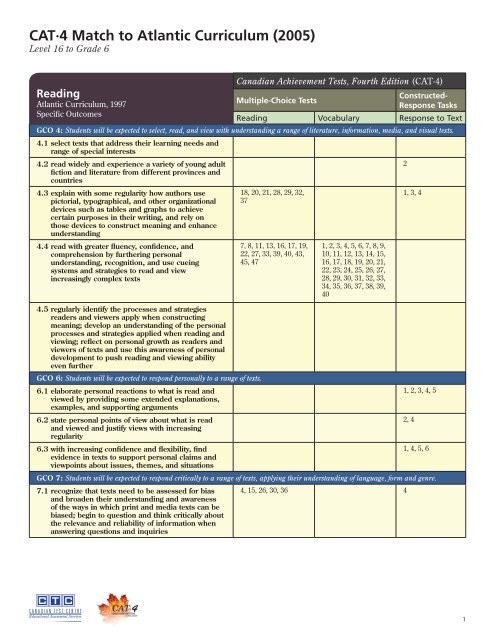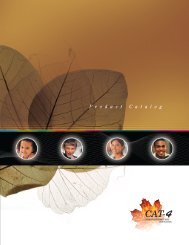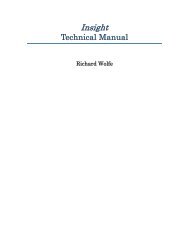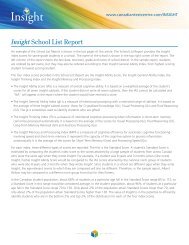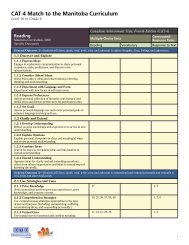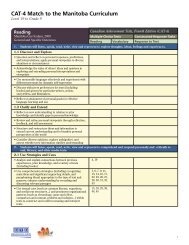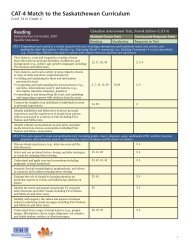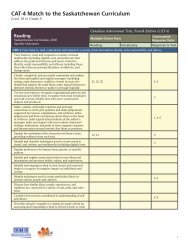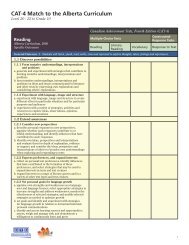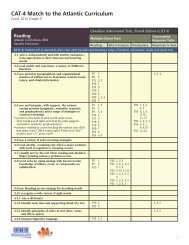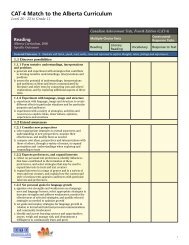Grade 6 - Canadian Test Centre
Grade 6 - Canadian Test Centre
Grade 6 - Canadian Test Centre
You also want an ePaper? Increase the reach of your titles
YUMPU automatically turns print PDFs into web optimized ePapers that Google loves.
CAT∙4 Match to Atlantic Curriculum (2005)<br />
Level 16 to <strong>Grade</strong> 6<br />
Reading<br />
Atlantic Curriculum, 1997<br />
Specific Outcomes<br />
<strong>Canadian</strong> Achievement <strong>Test</strong>s, Fourth Edition (CAT·4)<br />
Multiple-Choice <strong>Test</strong>s<br />
Constructed-<br />
Response Tasks<br />
Reading Vocabulary Response to Text<br />
GCO 4: Students will be expected to select, read, and view with understanding a range of literature, information, media, and visual texts.<br />
4.1 select texts that address their learning needs and<br />
range of special interests<br />
4.2 read widely and experience a variety of young adult<br />
fiction and literature from different provinces and<br />
countries<br />
4.3 explain with some regularity how authors use<br />
pictorial, typographical, and other organizational<br />
devices such as tables and graphs to achieve<br />
certain purposes in their writing, and rely on<br />
those devices to construct meaning and enhance<br />
understanding<br />
4.4 read with greater fluency, confidence, and<br />
comprehension by furthering personal<br />
understanding, recognition, and use cueing<br />
systems and strategies to read and view<br />
increasingly complex texts<br />
4.5 regularly identify the processes and strategies<br />
readers and viewers apply when constructing<br />
meaning; develop an understanding of the personal<br />
processes and strategies applied when reading and<br />
viewing; reflect on personal growth as readers and<br />
viewers of texts and use this awareness of personal<br />
development to push reading and viewing ability<br />
even further<br />
GCO 6: Students will be expected to respond personally to a range of texts.<br />
6.1 elaborate personal reactions to what is read and<br />
viewed by providing some extended explanations,<br />
examples, and supporting arguments<br />
6.2 state personal points of view about what is read<br />
and viewed and justify views with increasing<br />
regularity<br />
6.3 with increasing confidence and flexibility, find<br />
evidence in texts to support personal claims and<br />
viewpoints about issues, themes, and situations<br />
18, 20, 21, 28, 29, 32,<br />
37<br />
7, 8, 11, 13, 16, 17, 19,<br />
22, 27, 33, 39, 40, 43,<br />
45, 47<br />
1, 2, 3, 4, 5, 6, 7, 8, 9,<br />
10, 11, 12, 13, 14, 15,<br />
16, 17, 18, 19, 20, 21,<br />
22, 23, 24, 25, 26, 27,<br />
28, 29, 30, 31, 32, 33,<br />
34, 35, 36, 37, 38, 39,<br />
40<br />
2<br />
1, 3, 4<br />
1, 2, 3, 4, 5<br />
2, 4<br />
1, 4, 5, 6<br />
GCO 7: Students will be expected to respond critically to a range of texts, applying their understanding of language, form and genre.<br />
7.1 recognize that texts need to be assessed for bias<br />
and broaden their understanding and awareness<br />
of the ways in which print and media texts can be<br />
biased; begin to question and think critically about<br />
the relevance and reliability of information when<br />
answering questions and inquiries<br />
4, 15, 26, 30, 36 4<br />
1
CAT∙4 Match to Atlantic Curriculum (2005)<br />
Level 16 to <strong>Grade</strong> 6<br />
Reading<br />
Atlantic Curriculum, 1997<br />
Specific Outcomes<br />
7.2 identify the various features and elements writers<br />
use when writing for specific readers for specific<br />
purposes; describe how texts are organized to<br />
accommodate particular readers’ needs and to<br />
contribute to meaning and effect<br />
7.3 expand on earlier abilities to respond critically to a<br />
range of texts in various ways<br />
• understand how personal knowledge, ideas, values,<br />
perceptions, and points of view influence how writers<br />
create texts<br />
• recognize how and when personal background influences<br />
meaning construction, understanding, and textual<br />
response<br />
• recognize that there are values inherent in a text, and<br />
begin to identify those values<br />
• describe how cultures and reality are portrayed in media<br />
texts<br />
<strong>Canadian</strong> Achievement <strong>Test</strong>s, Fourth Edition (CAT·4)<br />
Multiple-Choice <strong>Test</strong>s<br />
Constructed-<br />
Response Tasks<br />
Reading Vocabulary Response to Text<br />
2, 3, 9, 10, 24, 25, 35,<br />
38, 41, 42, 44<br />
1, 5, 6, 12, 14, 31, 34,<br />
46, 48<br />
1, 3, 4, 5<br />
2, 4, 6<br />
2
CAT∙4 Match to Atlantic Curriculum (2005)<br />
Level 16 to <strong>Grade</strong> 6<br />
Writing<br />
Atlantic Curriculum, 1997<br />
Specific Outcomes<br />
<strong>Canadian</strong> Achievement <strong>Test</strong>s, Fourth Edition (CAT·4)<br />
Multiple-Choice <strong>Test</strong>s<br />
Writing<br />
Conventions<br />
Spelling<br />
Constructed-Response Tasks<br />
Writing<br />
GCO 8: Students will be expected to use writing and other forms of representation to explore, clarify, and reflect on their thoughts, feelings,<br />
experiences, and learnings; and to use their imaginations<br />
8.1 demonstrate competence in the frequent use<br />
of writing and representing strategies to extend<br />
learning; to explore their own thoughts and<br />
consider others’ ideas, to reflect on their feelings,<br />
values, and attitudes; and to identify problems and<br />
describe logical solutions<br />
8.2 identify and reflect upon strategies that are<br />
effective in helping them to learn; describe their<br />
personal growth as language learners and language<br />
users<br />
8.3 begin to use various forms of note-making<br />
appropriate to various purposes and situations<br />
8.4 demonstrate an awareness of how and when to<br />
integrate interesting effects in imaginative writing<br />
and other ways of representing<br />
• include thoughts and feelings in addition to external<br />
descriptions and activities<br />
• integrate detail that add richness and density<br />
• identify and correct inconsistencies and avoid extraneous<br />
detail<br />
• make effective language choices relevant to style and<br />
purpose<br />
• when appropriate, select more elaborate and sophisticated<br />
vocabulary and phrasing<br />
22, 23, 24, 25,<br />
26, 27, 28, 29,<br />
30, 31, 32, 33,<br />
34, 35, 36, 37,<br />
38, 39, 40<br />
1, 2, 3, 4, 5<br />
GCO 9: Students will be expected to create texts collaboratively and independently, using a variety of forms for a range of audiences and<br />
purposes.<br />
9.1 continue to develop writing forms previously<br />
introduced and expand this range to produce, for<br />
example, autobiographies, drama, surveys, graphs,<br />
literary responses, biographies, illustrations, and<br />
reviews<br />
9.2 consider and choose writing forms that match<br />
both the writing purpose (to define, report,<br />
persuade, compare) and the reader for whom the<br />
text is intended (understand why language choice,<br />
organization, and voice used in an essay differs<br />
from that used in a media advertisement)<br />
9.3 understand that ideas can be represented in<br />
more than one way and used with other forms of<br />
representing (speeches, demonstrations, plays)<br />
9.4 keep the reader and purpose for writing in mind<br />
when choosing content, writing style, tone of voice,<br />
language choice, and text organization<br />
9.5 know how and when to ask for reader feedback<br />
while writing and incorporate appropriate<br />
suggestions when revising subsequent drafts;<br />
assess self-generated drafts from a reader’s/<br />
viewer’s/listener’s perspective<br />
1, 3<br />
2, 3, 4, 5<br />
4<br />
1, 2, 3, 4, 5<br />
3
CAT∙4 Match to Atlantic Curriculum (2005)<br />
Level 16 to <strong>Grade</strong> 6<br />
Writing<br />
Atlantic Curriculum, 1997<br />
Specific Outcomes<br />
<strong>Canadian</strong> Achievement <strong>Test</strong>s, Fourth Edition (CAT·4)<br />
Multiple-Choice <strong>Test</strong>s<br />
Writing<br />
Conventions<br />
Spelling<br />
Constructed-Response Tasks<br />
Writing<br />
GCO 10: Students will be expected to use a range of strategies to develop effective writing and other ways of representing and to enhance<br />
their clarity, precision, and effectiveness<br />
10.1 build and rely upon a broad knowledge base of<br />
how words are spelled and formed; use such<br />
knowledge to spell unfamiliar words and expand<br />
vocabulary; regularly use resource texts to<br />
verify spelling; use punctuation and grammatical<br />
structures capably and accurately; use a variety<br />
of sentence patterns, vocabulary choices, and<br />
paragraphing with flexibility and creatively to<br />
engage readers<br />
10.2 choose with increasing regularity, the prewriting,<br />
drafting, revising, editing, proofreading, and<br />
presentations strategies to aid in producing<br />
various texts<br />
10.3 attempt to use various technologies for<br />
communicating to a variety of audiences for a<br />
range of purposes<br />
10.4 demonstrate a commitment to crafting pieces of<br />
writing and other representations<br />
10.5 gather information from a variety of sources<br />
(interviews, film, CD-ROMs, texts) and integrate<br />
ideas in communication<br />
1, 2, 3, 4, 5, 6,<br />
7, 8, 9, 10, 11,<br />
12, 13, 14, 15,<br />
16, 17, 18, 19,<br />
20, 21<br />
1, 2, 3, 4, 5, 6,<br />
7, 8, 9, 10, 11,<br />
12, 13, 14, 15,<br />
16, 17, 18, 19,<br />
20, 21, 22, 23,<br />
24, 25, 26, 27,<br />
28, 29, 30<br />
1, 2, 3, 4, 5<br />
4
CAT∙4 Match to Atlantic Curriculum (2005)<br />
Level 16 to <strong>Grade</strong> 6<br />
Mathematics<br />
Atlantic Provinces Curriculum<br />
Number Concepts<br />
A1 represent, estimate, and order numbers to billions using<br />
fraction and decimal<br />
<strong>Canadian</strong> Achievement <strong>Test</strong>s, Fourth Edition (CAT·4)<br />
Multiple-Choice <strong>Test</strong>s<br />
Mathematics<br />
55 22<br />
A2 represent, compare and order fractions and decimals 15, 19, 31, 44<br />
A3 write and interpret ratios, comparing part-to-part and<br />
part-to-whole<br />
A4 demonstrate an understanding of equivalent ratios 29, 49<br />
A5 demonstrate an understanding of the concept of percent<br />
as a ratio<br />
A6 demonstrate an understanding of the meaning of a<br />
negative integer<br />
A7 read and write whole numbers to billions using standard<br />
and expanded form<br />
A8 demonstrate an understanding of the place value system 48<br />
A9 relate fractional and decimal forms of numbers 27, 53<br />
A10 determine factors and greatest common factors of two<br />
numbers<br />
A11 distinguish between prime and composite numbers<br />
Number and Relationship Operations<br />
B1 compute products of whole numbers and decimals to<br />
thousandths<br />
B2 model and calculate the products of two decimal<br />
numbers<br />
B3 compute quotients of whole numbers and decimals using<br />
up to 2-digit whole number divisors<br />
B4 model and calculate the quotients of two decimals up to<br />
2-digit divisors<br />
B5 add and subtract simple fractions using models<br />
B6 demonstrate an understanding of the function nature of<br />
input-output situations<br />
B7 solve and create relevant addition, subtraction,<br />
multiplication and division problems involving whole<br />
numbers<br />
B8 solve and create relevant addition, subtraction,<br />
multiplication and division problems involving decimals<br />
B9 estimate products and quotients involving whole<br />
numbers only, whole numbers and decimals, and<br />
decimals only<br />
53<br />
50<br />
Computation<br />
and Estimation<br />
3, 10, 12, 15, 20,<br />
23, 25, 29, 31, 34<br />
1, 14, 19<br />
2, 4, 5, 6, 7, 11, 16<br />
9, 17, 23, 59 8, 9, 13, 18, 21,<br />
26, 32<br />
B10 divide numbers by 0.1, 0.01 and 0.001 mentally 24<br />
B11 calculate sums and differences in relevant contexts by<br />
using the most appropriate method<br />
33<br />
30<br />
Constructed-Response Tasks<br />
Math Processes<br />
5
CAT∙4 Match to Atlantic Curriculum (2005)<br />
Level 16 to <strong>Grade</strong> 6<br />
Mathematics<br />
Atlantic Provinces Curriculum<br />
B12 calculate products and quotients in relevant contexts by<br />
using the most appropriate method<br />
Patterns and Relations<br />
<strong>Canadian</strong> Achievement <strong>Test</strong>s, Fourth Edition (CAT·4)<br />
Multiple-Choice <strong>Test</strong>s<br />
Mathematics<br />
C1 solve problems involving patterns 4, 5, 18, 20,<br />
28, 34<br />
C2 use patterns to explore division by 0.1, 0.01 and 0.001<br />
C3 recognize and explain how changes in base or height<br />
affect areas and rectangles, parallelograms and triangles<br />
C4 recognize and explain how changes in height, depth or<br />
length affect volumes of rectangular prisms<br />
C5 recognize and explain how a change in one term of a<br />
ratio affects the other term<br />
C6 represent equivalent ratios using tables and graphs<br />
C7 represent square and triangular numbers concretely,<br />
pictorially and symbolically<br />
C8 solve simple linear equations using open frames 7<br />
C9 demonstrate an understanding of the use of letters to<br />
replace open frames<br />
Shape and Space<br />
D1 use the relationship among particular SI units to<br />
compare objects<br />
D2 describe mass measurements in tonnes<br />
D3 demonstrate an understanding of the relationship<br />
between capacity and volume<br />
Computation<br />
and Estimation<br />
60 17, 27, 28, 35<br />
35, 36<br />
D4 estimate and measure angles using a protractor 25, 42<br />
D5 draw angles of a given size<br />
D6 solve measurement problems involving length, capacity,<br />
area, volume, mass and time<br />
D7 demonstrate an understanding of the relationship among<br />
the bases, heights and areas of parallelograms<br />
D8 demonstrate an understanding of the relationship<br />
between the area of a triangle and parallelogram<br />
D9 demonstrate an understanding of the relationships<br />
between the dimensions of prisms and volume and<br />
surface area<br />
Shape and Space<br />
E1 describe and represent the various cross-sections of<br />
cones, cylinders, pyramids and prisms<br />
E2 make and interpret orthographic drawings of 3-D shapes<br />
made with cubes<br />
E3 make and apply generalizations about the sum of the<br />
angles in triangles and quadrilaterals<br />
49<br />
6<br />
22, 32, 47, 51<br />
33<br />
Constructed-Response Tasks<br />
Math Processes<br />
6
CAT∙4 Match to Atlantic Curriculum (2005)<br />
Level 16 to <strong>Grade</strong> 6<br />
Mathematics<br />
Atlantic Provinces Curriculum<br />
E4 make and apply generalizations about the diagonal<br />
properties of trapezoids, kites, parallelograms and<br />
rhombi<br />
E5 sort the members of the quadrilateral “family” under<br />
property headings<br />
E6 recognize, name, describe and represent similar figures<br />
E7 make generalizations about the planes of symmetry of<br />
3-D shapes<br />
E8 make generalizations about the rotational symmetry<br />
property of all members of the quadrilateral “family” and<br />
of regular polygons<br />
E9 recognize and represent dilatation images of 2-D figures<br />
and connect to similar figures<br />
E10 predict and represent the result of combining<br />
transformations<br />
<strong>Canadian</strong> Achievement <strong>Test</strong>s, Fourth Edition (CAT·4)<br />
Multiple-Choice <strong>Test</strong>s<br />
Mathematics<br />
Foundation Spatial Sense skills 14, 21, 24, 26,<br />
40, 41, 43, 54<br />
Data Management and Probability<br />
F1 choose and evaluate appropriate samples for data<br />
collection<br />
F2 identify various types of data sources<br />
F3 plot coordinates in four quadrants 2<br />
F4 use bar graphs, double bar graphs and stem-and-leaf<br />
plots to display data<br />
F5 use circle graphs to represent proportions 57<br />
F6 interpret data represented in scatterplots<br />
F7 make inferences from data displays including bar graphs,<br />
double bar graphs, and stem-and-leaf plots<br />
F8 demonstrate an understanding of the difference between<br />
mean, median and mode<br />
F9 explore relevant issues for which data collection assists<br />
in reaching conclusions<br />
G1 conduct simple simulations to determine probabilities<br />
G2 evaluate the reliability of sampling results<br />
G3 analyse simple probabilistic claims 39<br />
1, 3<br />
8, 10, 38<br />
G4 determine theoretical probabilities 11, 12, 30, 37,<br />
56<br />
G5 identify events that might be associated with a particular<br />
theoretical probability<br />
52<br />
Computation<br />
and Estimation<br />
Constructed-Response Tasks<br />
Math Processes<br />
7


